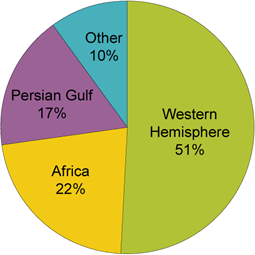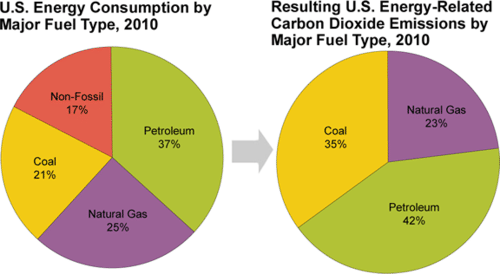Energy for lighting, heating, and cooling our buildings, manufacturing products, and powering our transportation systems comes from various natural sources. The earth’s core provides geothermal energy. The gravitational pull of the moon and sun creates tides. The sun emits light (electromagnetic radiation), which creates the wind, powers the water (hydrologic) cycle, and enables photosynthesis. Plants, algae, and cyanobacteria utilize solar energy to grow and create biomass that can be burned and used for biofuels, such as wood, biodiesel, and bioethanol. Over the course of millions of years, biomass from photosynthetic organisms can create energy-rich fossil fuels through the geologic process of burial and transformation through heat and pressure.
Each of these types of energy can be defined as renewable or non-renewable. Renewable energy sources can be replenished within human lifespans. Examples include solar, wind, and biomass energy. Non-renewable energy is finite and cannot be replenished within a human timescale. Examples include nuclear energy and fossil fuels, which take millions of years to form. All energy sources have some environmental and health costs, and energy distribution is not equally distributed among all nations.
Environmental and Health Challenges of Energy Use
The environmental impacts of energy use on humans and the planet can happen anywhere during the life cycle of the energy source. The impacts begin with the extraction of the resource. They continue with the processing, purification, or manufacture of the source; its transportation to the place of energy generation, and ends with the disposal of waste generated during use.
The extraction of fossil fuels can be used as a case study because its use significantly impacts the environment. As we mine deeper into mountains, farther out at sea, or farther into pristine habitats, we risk damaging fragile environments, and the results of accidents or natural disasters during extraction processes can be devastating. Fossil fuels are often located far from where they are utilized, so they need to be transported by pipeline, tankers, rail, or trucks. These all present the potential for accidents, leakage, and spills. When transported by rail or truck, energy must be expended, and pollutants are generated. Processing petroleum, gas, and coal generates various emissions and wastes and utilizes water resources. Energy production at power plants results in air, water, and, often, waste emissions. Power plants are highly regulated in the United States by federal and state law under the Clean Air and Clean Water Acts, while the Nuclear Regulatory Commission regulates nuclear power plants.
Geopolitical Challenges of Fossil Fuels

Using fossil fuels has allowed much of the global population to reach a higher standard of living. However, this dependence on fossil fuels results in many significant impacts on society. Our modern technologies and services, such as transportation and plastics, depend in many ways on fossil fuels. If supplies become limited or extremely costly, our economies are vulnerable. If countries do not have their own fossil fuel reserves, they incur even more risk. The United States had become increasingly dependent on foreign oil since 1970 when our oil production peaked. The United States imported over half of the crude oil and refined petroleum products we consumed in 2009. Over half of these imports came from the Western Hemisphere (Figure 2).
The Organization of Petroleum Exporting Countries (OPEC; Figure 3) is the major holder of oil reserves. As of 2018, there were 15 member countries in OPEC: Algeria, Angola, Congo, Ecuador, Equatorial Guinea, Gabon, Iran, Iraq, Kuwait, Libya, Nigeria, Qatar, Saudi Arabia, the United Arab Emirates, and Venezuela. OPEC attempts to influence the amount of oil available to the world by assigning a production quota to each member except Iraq, for which no quota is presently set.



